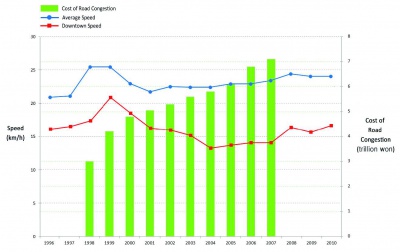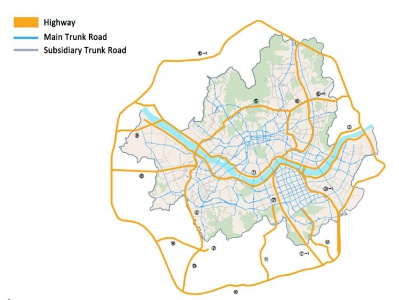"Seoul - 5.6 Congested Streets and Rising Environmental Pollution"의 두 판 사이의 차이
(→Rising Air Pollution and “Clear” Seoul) |
잔글 (→Congested Roads and Mass Transportation) |
||
| 18번째 줄: | 18번째 줄: | ||
In turn the Seoul Metropolitan Government adapted policies to manage traffic demands instead of expanding traffic infrastructure. The Downtown Traffic Congestion Toll is imposed on vehicles entering downtown, and drivers are encouraged to take a break from driving one day a week through the Voluntary Vehicle-Free Day System. In fact various projects that promote the use of mass transportation system are in operation: the ‘Vehicle-free Promenade Event’ is held annually; the Exclusive Bus Lane System has been introduced; more subway lines have been added; the transfer system has been improved; and more bicycle lanes have been added. As a result of these efforts, both bus and subway public transportation systems are gaining recognition as the most convenient, safe and inexpensive mode of transportation in Seoul. On average 10,554,000 people per day ride the subway as of 2010 and the subway became the choice transportation for the citizens of Seoul. | In turn the Seoul Metropolitan Government adapted policies to manage traffic demands instead of expanding traffic infrastructure. The Downtown Traffic Congestion Toll is imposed on vehicles entering downtown, and drivers are encouraged to take a break from driving one day a week through the Voluntary Vehicle-Free Day System. In fact various projects that promote the use of mass transportation system are in operation: the ‘Vehicle-free Promenade Event’ is held annually; the Exclusive Bus Lane System has been introduced; more subway lines have been added; the transfer system has been improved; and more bicycle lanes have been added. As a result of these efforts, both bus and subway public transportation systems are gaining recognition as the most convenient, safe and inexpensive mode of transportation in Seoul. On average 10,554,000 people per day ride the subway as of 2010 and the subway became the choice transportation for the citizens of Seoul. | ||
| − | |||
| − | |||
| − | |||
| − | |||
| − | |||
| − | |||
| − | |||
| − | |||
==Rising Air Pollution and “Clear” Seoul== | ==Rising Air Pollution and “Clear” Seoul== | ||
2017년 1월 13일 (금) 00:50 판
Congested Roads and Mass Transportation
Up until the mid-1980s the roads of downtown Seoul were not congested with exception of the rush hour period, but the roads became congested regardless of the hour of day beginning from the late 1980s. There were 200,000 cars in Seoul in 1980, but this number dramatically increased to 1,000,000 in 1990 and to 2,980,000 in 2010. The rate of increase in number of cars exceeded the rate of increase of the length of road extension. Indicative is the average traveling speed in Seoul which is 24Km/h (16km/h in downtown area); the roadway in Seoul is very crowded. This has had detrimental effects on citizens’ quality of life. The financial loss, environmental cost and traffic congestion cost continued to increase and reached 7 trillion won or about 26% of Seoul’s total budget (27 trillion won) in 2007.
This traffic congestion is caused not only by the rate of increase in the number of cars that exceeds supply of infrastructure such as roads but is also related to commute patterns. The people living in satellite cities of the metropolitan area commute to Seoul, and the people living in Seoul commute to downtown or Gangnam. Ironically, the metropolitan traffic network consists of Gangbyeon Expressway, Olympic Expressway, Dongbu Expressway, Suseo Highway, Naebu Express way, and Oibu Expressway built to assist smoother entry into Seoul from new cities such as Bundang and Ilsan which have ended up exacerbating the traffic congestion.
In turn the Seoul Metropolitan Government adapted policies to manage traffic demands instead of expanding traffic infrastructure. The Downtown Traffic Congestion Toll is imposed on vehicles entering downtown, and drivers are encouraged to take a break from driving one day a week through the Voluntary Vehicle-Free Day System. In fact various projects that promote the use of mass transportation system are in operation: the ‘Vehicle-free Promenade Event’ is held annually; the Exclusive Bus Lane System has been introduced; more subway lines have been added; the transfer system has been improved; and more bicycle lanes have been added. As a result of these efforts, both bus and subway public transportation systems are gaining recognition as the most convenient, safe and inexpensive mode of transportation in Seoul. On average 10,554,000 people per day ride the subway as of 2010 and the subway became the choice transportation for the citizens of Seoul.
Rising Air Pollution and “Clear” Seoul
Mountains surround Seoul from the east, north and south, making the west the only open direction. This geographical formation makes the circulation of air polluted by pollutants like the yellow-dust from China and the smoke fumed by cars difficult and cause the air in the city to remain seriously polluted. The citizens of Seoul regarded ‘air pollution’ as the most serious environmental issue (69.3%); and the most urgent environmental policy for the city of Seoul was creating ‘clear Seoul.’
In order to reduce air pollution level the city reduced the number of diesel cars and required emission control devices such as DPF (Diesel Particulate Filter) and DOC (Diesel Oxidation Calalytic) to be installed on vehicles. Usage of clean energy and supplying more low-emission vehicles were also encouraged. As a result of this series of efforts to reduce pollution caused by cars, the concentration of carbon monoxide and sulfurous acid gas has decreased in the city. Another effort is the use of recycled underground water discharged by the subway in full-scale to clean the fine dusts on the roadside. Air pollution in the city is decreasing in general even though the concentration level of nitrogen dioxide (0.03 ppm), fine dusts and ozone still exceeds the environmental standard from time to time. The concentration level of fine dust is in a decreasing trend from 83 microgram per square meter in 2002 to 62 microgram per square meter in 2005, and 55 microgram per square meter in 2009.
The number of days with a visibility of 20 kilometers or better increased from 19 days in 2009 to 62 days in 2009. In short the air pollution problem that citizens have experienced has been improving.





